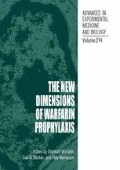Abstract
Using the smallest effective dose of warfarin, clearly will diminish hemorrhage. But there are more than a dozen factors other than dose that can either favorably effect the benefit/risk ratio or tell the physician that he should or should not consider using warfarin in specific patient groups. Three of these factors, the prothrombin time, warfarin resistance, and drug-drug interactions, have already been commented upon at this symposium and so I shall discuss several other factors.
Access this chapter
Tax calculation will be finalised at checkout
Purchases are for personal use only
Preview
Unable to display preview. Download preview PDF.
References
S. Wessler, A Guide to Anticoagulant Therapy, American Heart Association, 1984.
S. Wessler, Is anticoagulant prophylaxis of cardiac emboli practical?, Geriatrics (in press).
J. G. Hall, R. M. Pauli, and K. M. Wilson, Maternal and fetal sequelae of anticoagulation during pregnancy. Am J Med 68:122(1980).
R. A. O’Reilly, and P. M. Aggeler, Determination of the response to oral anticoagulant drugs in man. Pharmacol Rev 22:35, 1980.
K. Fries, F. E. Konig, and T. Reich, Einfluss der Marcoumar-Therapie bei voll gestillten kindern, Schweiz Med Wochen Schr, 87:615(1957).
E. Marciniak, and J. P. Gockerman, Heparin-induced decrease in circulating antithrombin III, Lancet 2:581(1977).
S. Wessler, S. N. Gitel, H. Bank, U. Martinowitz, and R. C. Stephenson, An assay of the antithrombotic action of warfarin: its correlation with the inhibition of stasis thrombosis in rabbits, Thromb Haemost 40:486(1978).
J. G. Domenet, D. W. Evans, and H. Stephenson, Anticoagulants in congestive heart failure, Brit Med J, 2:866(1966).
W. W. Coon, and P. W. Willis III, Thromboembolic complications during anticoagulant therapy, Arch Surg 105:209(1972).
The Working Group on Hypertension in the Elderly. Statement on hypertension in the elderly, JAMA, 256:70(1986).
Author information
Authors and Affiliations
Editor information
Editors and Affiliations
Rights and permissions
Copyright information
© 1987 Springer Science+Business Media New York
About this chapter
Cite this chapter
Wessler, S. (1987). Improving the Benefit/Risk Ratio. In: Wessler, S., Becker, C.G., Nemerson, Y. (eds) The New Dimensions of Warfarin Prophylaxis. Springer, Boston, MA. https://doi.org/10.1007/978-1-4757-5985-3_19
Download citation
DOI: https://doi.org/10.1007/978-1-4757-5985-3_19
Publisher Name: Springer, Boston, MA
Print ISBN: 978-1-4757-5987-7
Online ISBN: 978-1-4757-5985-3
eBook Packages: Springer Book Archive

